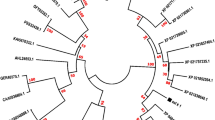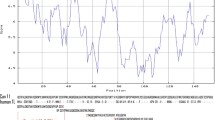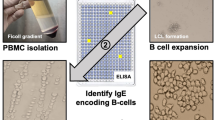Abstract
Rationale
Epitopes were delineated for allergenic proteins, but studies are required to identify residues mediating IgE binding. In the present study, the in silico approach was used to identify IgE-binding residues of Alt a 131–50 fragment and confirmed by experimental approach.
Method and Results
IgE-binding epitopes of Alt a 13 mapped computationally were cloned, expressed, purified, and characterized using various immunochemical and biophysical methods. Among four fragments of Alt a 13, Alt a 131–50 demonstrated maximum IgE binding with two immunodominant regions and was mutated at these regions. The mutation in first region, Alt a 131–50-K4A_S6F, did not show any change in immunological and biophysical properties of protein. However, mutations in the second region, Alt a 131–50-T21F_N27I, caused reduced IgE binding, histamine release, and low IL-4 release on stimulation of Alternaria alternata positive patients peripheral blood mononuclear cells in vitro.
Conclusion
This suggests that residues T21 and N27 are important for the secondary structure. In conclusion, Alt a 131–50-T21F_N27I with reduced Th 2 response and intact T-cell proliferation capacity has potential for clinical use.





Similar content being viewed by others
References
Crameri R, Weichel M, Fluckiger S, Glaser AG, Rhyner C. Fungal allergies: a yet unsolved problem. Chem Immunol Allergy 2006;91:121–33.
Gioulekas D, Damialis A, Papakosta D, Spieksma F, Giouleka P, Patakas DJ. Allergenic fungi spore records (15 years) and sensitization in patients with respiratory allergy in Thessaloniki—Greece Investig. Allergol Clin Immunol 2004;14:225–31.
Kurup VP. Fungal allergens. Curr Allergy Asthma Rep 2003;3:416–23. doi:10.1007/s11882-003-0078-6.
Schneider PB, Denk U, Breitenbach M, Richterm K, Schmid-Grendelmeier P, Nobbe S, et al. Alternaria alternata NADP-dependent mannitol dehydrogenase is an important fungal allergen. Clin Exp Allergy 2006;36:1513–24. doi:10.1111/j.1365-2222.2006.02582.x.
Weber RW. Alternaria alternata. Ann Allergy Asthma Immunol 2001;87:A–4.
Martin-Orozco E, Cardaba B, del Pozo V, de Andres B, Villalba M, Gallardo S, Rodriguez-Garcia MI, Fernandez MC, Alche JD, Rodriguez R. Ole e I: epitope mapping, cross-reactivity with other Oleaceae pollens and ultrastructural localization. Int Arch Allergy Immunol 1994;104:160–70.
Stanley JS, King N, Burks AW, Huang SK, Sampson H, Cockrell G. Identification and mutational analysis of the immunodominant IgE binding epitopes of the major peanut allergen Ara h 2. Arch Biochem Biophys 1997;2:244–53. doi:10.1006/abbi.1997.9998.
Hakkaart GA, Aalberse RC, van Ree R. Epitope mapping of the house-dust-mite allergen Der p 2 by means of site-directed mutagenesis. Allergy 1998;53:165–72. doi:10.1111/j.1398-9995.1998.tb03865.x.
Ong EK, Knox RB, Singh MB. Mapping of the antigenic and allergenic epitopes of Lol p VB using gene fragmentation. Mol Immunol 1995;32:295–302. doi:10.1016/0161-5890(94)00127-M.
Schramm G, Bufe A, Petersen A, Haas H, Merget R, Schlaak M, et al. Discontinuous IgE-binding epitopes contain multiple continuous epitope regions: results of an epitope mapping on recombinant Hol l 5, a major allergen from velvet grass pollen. Clin Exp Allergy 2001;31:331–41. doi:10.1046/j.1365-2222.2001.01049.x.
Wu CH, Lee MF, Tseng CY. IgE-binding epitopes of the American cockroach Per a 3 allergen. Allergy 2003;358:586–92.
Fedorov AA, Ball T, Mahoney NM, Valenta R, Almo SC. The molecular basis for allergen cross-reactivity: crystal structure and IgE-epitope mapping of birch pollen profilin. Structure 1997;5:33–45. doi:10.1016/S0969-2126(97)00164-0.
Esch RE. Allergens. Clin Rev Allergy Immunol 2006;30:71–2. doi:10.1385/CRIAI:30:2:71.
Chan SL, Ong ST, Ong SY, Chew FT, Mok YK. Nuclear magnetic resonance structure-based epitope mapping and modulation of dust mite group 13 allergen as a hypoallergen. J Immunol 2006;176:4852–60.
Ferreira F, Ebner C, Kramer B, Casari G, Briza P, Kung AJ. Modulation of IgE reactivity of allergens by site-directed mutagenesis: potential use of hypoallergenic variants for immunotherapy. FASEB J 1998;12:231–42.
Banerjee B, Kurup VP, Greenberger PA, Kelly KJ, Fink JN. C-terminal cysteine residues determine the IgE binding of Aspergillus fumigatus allergen Asp f 2. J Immunol 2002;169:5137–44.
Marazuela EG, Rodriguez R, Barber D, Villalba M, Batanero E. Hypoallergenic mutants of Ole e 1, the major olive pollen allergen, as candidates for allergy vaccines. Clin Exp Allergy 2007;37:251–60. doi:10.1111/j.1365-2222.2006.02632.x.
O’Neill GM, Donovan GR, Baldo BA. Cloning and characterization of a major allergen of the house dust mite, Dermatophagoides pteronyssinus, homologous with glutathione S-transferase. Biochim Biophys Acta 1994;1219:521–8.
Arruda LK, Vailes LD, Platts-Mills TA, Hayden ML, Chapman MD. Induction of IgE antibody responses by glutathione S-transferase from the German cockroach (Blattella germanica). J Biol Chem 1997;272:20907–12. doi:10.1074/jbc.272.33.20907.
Shankar J, Gupta PD, Sridhara S, Singh BP, Gaur SN, Arora N. Immunobiochemical analysis of cross-reactive glutathione-S-transferase allergen from different fungal sources. Immunol Invest 2005;34:37–51. doi:10.1081/IMM-200047383.
Dougall A, Holt DC, Fischer K, Currie BJ, Kemp DJ, Walton SF. Identification and characterization of Sarcoptes scabiei and Dermatophagoides pteronyssinus glutathione S-transferases: implication as a potential major allergen in crusted scabies. Am J Trop Med Hyg 2005;73:977–84.
Shankar J, Singh BP, Gaur SN, Arora N. Recombinant glutathione-S-transferase a major allergen from Alternaria alternata for clinical use in allergy patients. Mol Immunol 2006;43:1927–32. doi:10.1016/j.molimm.2005.12.006.
Huang CH, Liew LM, Mah KW, Kuo IC, Lee BW, Chua K. Characterization of glutathione S-transferase from dust mite, Der p 8 and its immunoglobulin E cross-reactivity with cockroach glutathione S-transferase. Clin Exp Allergy 2006;36:369–76. doi:10.1111/j.1365-2222.2006.02447.x.
Jameson BA, Wolf H. The antigenic index: a novel algorithm for predicting antigenic determinants. Comput Appl Biosci 1988;4:181–6.
Saha S, Raghava GP. Prediction of continuous B-cell epitopes in an antigen using recurrent neural network. Proteins 2006;65:40–8. doi:10.1002/prot.21078.
Yu CJ, Chen YM, Su SN, Forouhar F, Lee SH, Chow LP. Molecular and immunological characterization and IgE epitope mapping of Pen n 18, a major allergen of Penicillium notatum. Biochem J 2002;363:707–15.
Mittag D, Batori V, Neudecker P, Wiche R, Friis EP, Ballmer-Weber BK. A novel approach for investigation of specific and cross-reactive IgE epitopes on Bet v 1 and homologous food allergens in individual patients. Mol Immunol 2006;43:268–78. doi:10.1016/j.molimm.2005.02.008.
Niederberger V, Horak F, Vrtala S. Vaccination with genetically engineered. allergens prevents progression of allergic disease. Proc Natl Acad Sci U S A 2004;101:14677–82. doi:10.1073/pnas.0404735101.
Verdino P, Keller W. Circular dichroism analysis of allergens. Methods 2004;32:241–8. doi:10.1016/j.ymeth.2003.08.017.
Beezhold DH, Hickey VL, Slater JE, Sussman GL. Human IgE-binding epitopes of the latex allergen Hev b 5. J Allergy Clin Immunol 1999;103:1166–72. doi:10.1016/S0091-6749(99)70194-6.
Cromwell O, Suck R, Kahlert H, Nandy A, Weber B, Fiebig H. Transition of recombinant allergens from bench to clinical application. Methods 2004;32:300–12. doi:10.1016/j.ymeth.2003.08.009.
Jeong KY, Hong CS, Yong TS. Recombinant allergens for diagnosis and immunotherapy of allergic disorders, with emphasis on cockroach allergy. Curr Protein Pept Sci 2006;7:57–71. doi:10.2174/138920306775474112.
Lebecque S, Dolecek C, Laffer S, Visco V, Denepoux S, Pin JJ, et al. Immunologic characterization of monoclonal antibodies that modulate human IgE binding to the major birch pollen allergen Bet v 1. J Allergy Clin Immunol 1997;99:374–84. doi:10.1016/S0091-6749(97)70056-3.
Takai T, Yokota T, Yasue M, Nishiyama C, Yuuki T, Mori A, et al. Engineering of the major house dust mite allergen Der f 2 for allergen- specific immunotherapy. Nat Biotechnol 1997;15:754-8. doi:10.1038/nbt0897-754.
Acknowledgements
Jay Shankar is an SRF from Council for Scientific and Industrial Research, New Delhi. Thanks are due to Sh. Dinesh Chandra, V.P.Chest Institute, Delhi for help in skin tests on patients. We sincerely thank the Council for Scientific and Industrial Research for the financial support for the study.
Author information
Authors and Affiliations
Corresponding author
Rights and permissions
About this article
Cite this article
Shankar, J., Singh, B.P., Gaur, S.N. et al. Engineered Alt a 13 Fragment of Alternaria alternata Abrogated IgE Binding without Affecting T-cell Stimulation. J Clin Immunol 29, 63–70 (2009). https://doi.org/10.1007/s10875-008-9224-1
Received:
Accepted:
Published:
Issue Date:
DOI: https://doi.org/10.1007/s10875-008-9224-1




